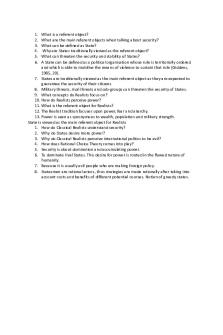Practical 1 - Object is to describe various surveying instruments with pictures. PDF

| Title | Practical 1 - Object is to describe various surveying instruments with pictures. |
|---|---|
| Author | Irtaza Mughal |
| Course | Surveying-1 |
| Institution | Mehran University of Engineering and Technology |
| Pages | 9 |
| File Size | 647.7 KB |
| File Type | |
| Total Downloads | 9 |
| Total Views | 133 |
Summary
Object is to describe various surveying instruments with pictures....
Description
Practical # 1 Object : Introduction to different surveying instruments. Following are the three types of measurements taken generally in a survey: 1. Distance 2. Angular Measurement 3. Elevation/Depression/Height/Depth Instruments for measuring distance : 1. Chains Chain consists of many small parts used for handling or reading the measurements. They have designated lengths. There are 4 types of chains: Gunter’s Chain (66 ft standard length divided in 100 links) Engineering Chain (100 ft length divided in 100 links) Metric Chain (5, 10, 20 and 30 m lengths. Most commonly used is 20m divided in 100 links) Revenue Chain (33 ft standard length divided in 16 lengths)
2. Tapes A tape is a flexible ruler and used to measure distance. There are different types of tapes: Cloth or Linear Tape Invar Tape (36% nickel & 64% steel) Steel Tape Fiber glass Tape
3. Passometer Passometer is an instrument that is used to count the number of a person's steps.
4. Pedometer Pedometer is an instrument that not only counts the number of a person’s steps, but also the distance traveled by walking directly with the help of average human steps already fed.
5. Odometer Odometer is an instrument used for measuring the distance travelled by a vehicle. It does this with the help of wheels.
6. Perambulator It is a handy device in which a single wheel is attached to a handle and the device can be pushed or pulled along by a person walking, while simultaneously measuring the distance moved. A dial is also present.
Instruments for Angular Measurements : 1. Surveyor’s Compass This type of compass has a graduated scale and a freely suspended needle. It points magnetic north and gives quadrantal bearing.
2. Prismatic Compass This type of compass has a graduated scale and an attached needle. It gives whole-circle bearing.
3. Clinometer Clinometer is a device used to measure angle of elevation and angle of depression. A surveyor’s compass is attached to it.
4. Indian Clinometer Indian clinometer is used for determining difference in elevation between two points and is often used in plane-table surveying.
5. Abney Level It is a handy instrument that measures angle of elevation as well as angle of depression. A protractor scale and an internal mirror are attached to it to measure angles accurately.
6. Optical Square This instrument measures the angles when two points on a mirror are at 90 degree from original points.
7. Plumb bob It is used to locate points in optical square and also for instrument standing.
8. Sextant box Sextant box can measure angles up to 120 degrees due to double reflection property. An arc of 1/6th of circle (60 degrees) has been designed. The vernier is moved until the image is clearly seen on the telescope. Sextant box is used to measure the areas of objects and also to observe horizon.
9. Auto Level This instrument measures horizontal angles. It is used for leveling and crosssections. The various parts of an Auto Level are: Tribatch(base) Bull’s Eye Telescope Object Lens Leveling Screw Cross-air Focusing Screw Horizontal Tangential Screw
10. Theodolite This instrument measures horizontal as well as vertical angles. It is transit i.e. it can rotate to 360 degrees.
11. Total Station This instrument has same function as that of theodolite except that it is advanced because EDM (Electromagnetic Distometer) is attached.
Instruments used to measure Elevation/Depression/Height/Depth: 1. Staff/Level Staff/Staff Rod A level staff is a graduated rod used to measure the level of the object vertically with respect to other object. It has two scales i.e. imperial scale having units m, cm, mm and metric scale having units ft, inch, furlong.
2. Ranging Rod A ranging rod is a surveying instrument used for marking the position of stations and for sightings of those stations as well as for ranging straight lines. There may be direct as well as indirect measurements possible.
3. Tacheometer A transit theodolite fitted with special stadia diaphragm is known as tacheometer. Its telescope contains two horizontal hairs called stadia hairs in addition to the regular crosshairs. The stadia hairs are equidistant from the central cross-hairs. Tacheometry is a system of rapid surveying, by which the positions, both horizontal and vertical, of points on the earth's surface relatively to one another are determined without using a chain or tape.
4. Planimeter This instrument is used to find area in maps using scales. Its rod is rotated to directly find the area.
General instruments useful in surveying 1. Tripod A tripod is a portable three-legged frame or stand, used as a platform for supporting the weight and maintaining the stability of some other object.
2. Arrow Arrows are used to mark the end of chain during the process of chaining....
Similar Free PDFs

Arthropod with pictures to study
- 3 Pages

Surveying practical 1.0
- 1 Pages

INTRODUCTION TO QUANTITY SURVEYING
- 42 Pages

What is a referent object
- 1 Pages

Surveying 3B chapter 1
- 9 Pages

What is a Digital Object?
- 17 Pages
Popular Institutions
- Tinajero National High School - Annex
- Politeknik Caltex Riau
- Yokohama City University
- SGT University
- University of Al-Qadisiyah
- Divine Word College of Vigan
- Techniek College Rotterdam
- Universidade de Santiago
- Universiti Teknologi MARA Cawangan Johor Kampus Pasir Gudang
- Poltekkes Kemenkes Yogyakarta
- Baguio City National High School
- Colegio san marcos
- preparatoria uno
- Centro de Bachillerato Tecnológico Industrial y de Servicios No. 107
- Dalian Maritime University
- Quang Trung Secondary School
- Colegio Tecnológico en Informática
- Corporación Regional de Educación Superior
- Grupo CEDVA
- Dar Al Uloom University
- Centro de Estudios Preuniversitarios de la Universidad Nacional de Ingeniería
- 上智大学
- Aakash International School, Nuna Majara
- San Felipe Neri Catholic School
- Kang Chiao International School - New Taipei City
- Misamis Occidental National High School
- Institución Educativa Escuela Normal Juan Ladrilleros
- Kolehiyo ng Pantukan
- Batanes State College
- Instituto Continental
- Sekolah Menengah Kejuruan Kesehatan Kaltara (Tarakan)
- Colegio de La Inmaculada Concepcion - Cebu









